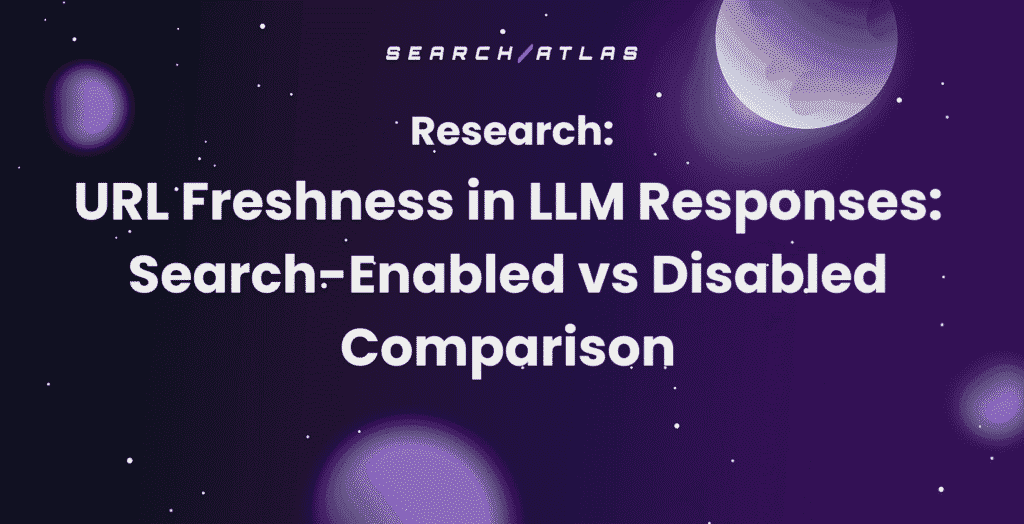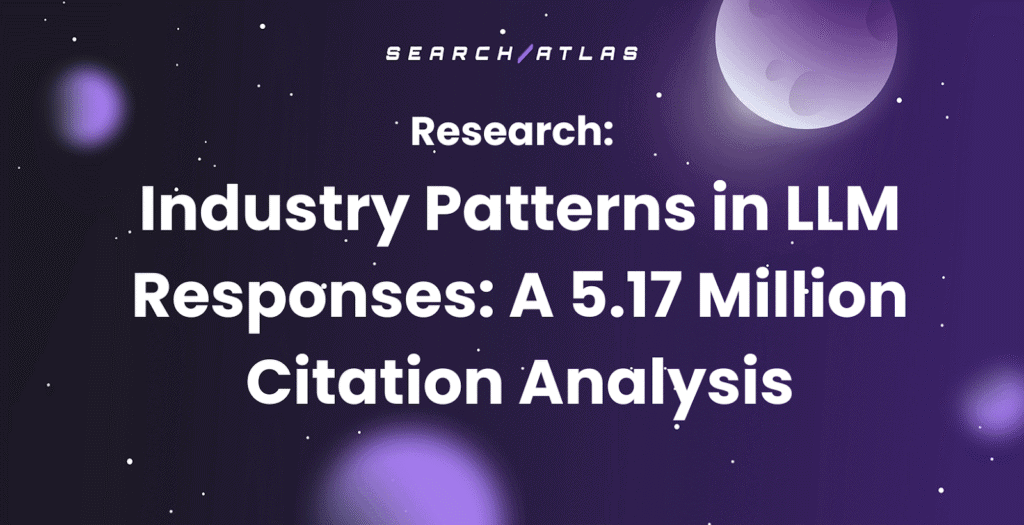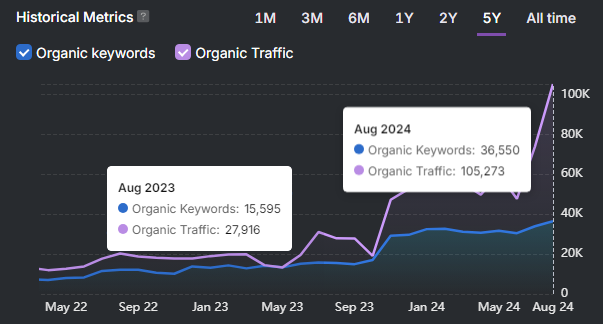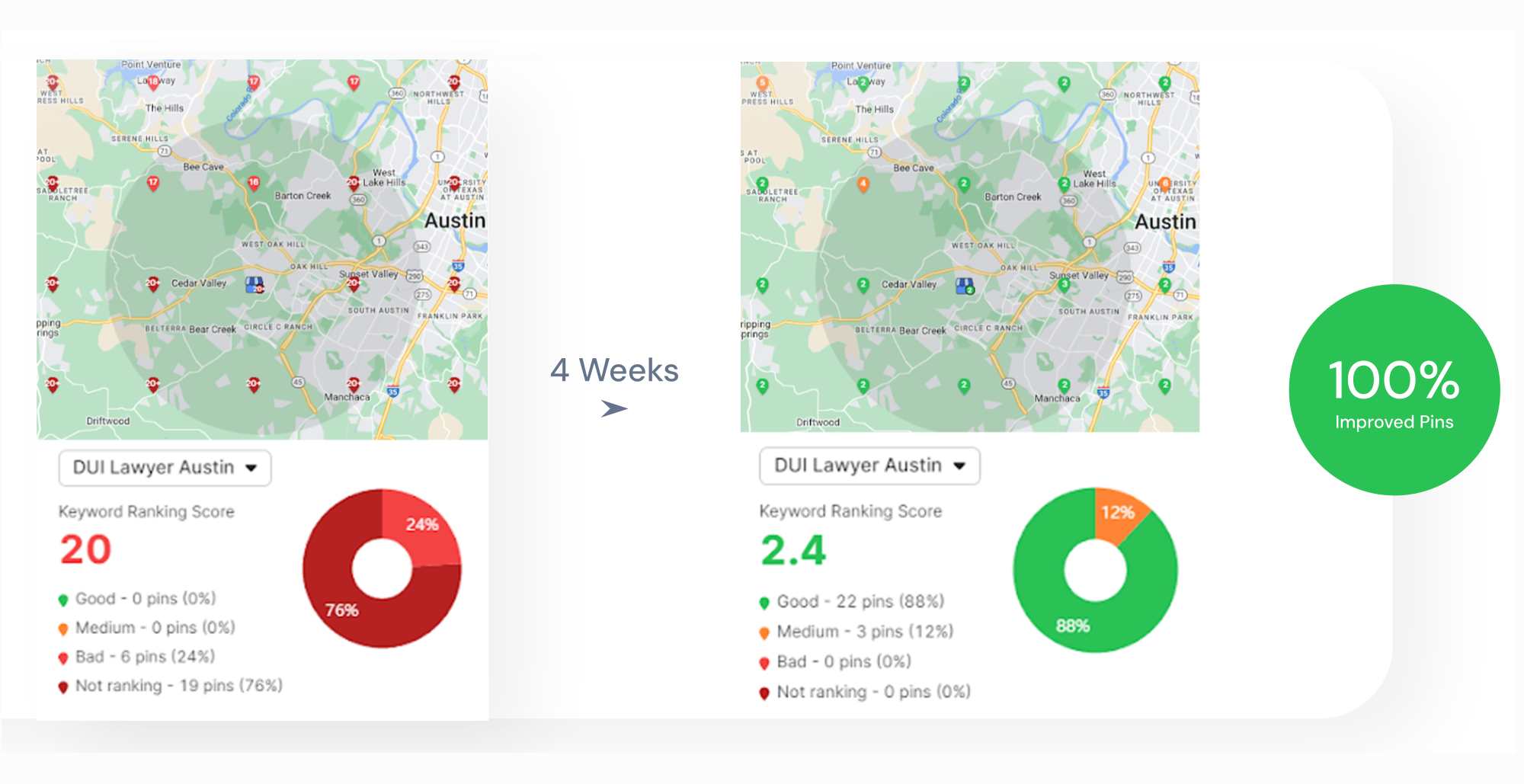Semrush is an SEO and digital marketing suite aimed at improving online visibility, tracking competitor activity, and optimizing content. Semrush covers core areas like keyword research, backlink monitoring, rank tracking, and site auditing. The main features of Semrush are Domain Overview, Keyword Magic Tool, and Organic Research.
Semrush’s pricing starts at a relatively high rate compared to other SEO tools, with limited flexibility on entry-level plans and extra costs for add-ons. A main pro of Semrush is its broad set of tools that streamline SEO efforts in one platform. A main con of Semrush is the high cost. This high cost can be prohibitive for freelancers, startups, or small teams who may not fully leverage the platform’s capabilities.
What is Semrush?
Semrush is a digital marketing platform that offers tools for SEO, paid advertising, content creation, social media marketing, and competitive analysis. Semrush is often used by businesses and marketing professionals aiming to monitor and improve their online visibility.
The Semrush software includes keyword research functions to identify search trends, site audits to highlight technical SEO problems, and backlink analysis to evaluate link profiles. Semrush users can perform domain comparisons, track search rankings, monitor brand mentions, and access content planning templates. However, the depth of certain Semrush features may not match more specialized tools.
The Semrush app is designed for use by agencies, SEO consultants, content marketers, and companies ranging from startups to enterprises. The Semrush platform offers multiple pricing tiers, but access to advanced features and larger usage limits typically requires higher-tier subscriptions. While the Semrush tool’s broad data coverage supports market research and tracking, users looking for greater flexibility, real-time data accuracy, or deeper collaboration features may find certain limitations depending on their specific needs.
What is the History of Semrush?
Semrush was founded in 2008 by Oleg Shchegolev and Dmitry Melnikov, two friends with a keen interest in SEO and emerging web technologies. Semrush originated in Moscow, Russia, and initially offered just two tools used by a small network of early users. The original focus of Semrush was on search engine optimization, aiming to help businesses navigate and adapt to evolving search engine practices.
However, Semrush broadened its platform beyond SEO over the years, adding tools for paid advertising, content marketing, and broader digital campaign management. The shift toward a more global approach became more visible in 2017, when the founders of Semrush moved operations to the United States, aligning the company with a growing international customer base.
In March 2021, the Semrush company went public on the New York Stock Exchange under the ticker NYSE: SEMR. Financial disclosures at the time reported $213 million in revenue and a customer base of over 82,000. In 2022, Semrush announced the closure of its operations in Russia and provided relocation options to affected staff in response to global events. The move marked a significant shift in the company’s operational footprint and public positioning during a politically sensitive period. Semrush currently holds American nationality and operates as a public company headquartered in Boston, Massachusetts, with multiple offices in Europe and the U.S.
Who is the Semrush Tool For?
The Semrush Tool is for digital marketing professionals, SEO specialists, content marketers, and marketing agencies who need a broad set of tools to oversee multiple aspects of online marketing. The Semrush platform caters to a range of businesses, from smaller companies aiming to enhance their digital footprint to large organizations requiring detailed analytics and competitive insights across SEO, PPC, content, and social media channels.
The Semrush platform appeals mainly to marketing teams that prefer a unified solution instead of managing several specialized tools. However, the tool’s extensive features and pricing structure make it more suited for established marketers with allocated budgets than casual users or complete beginners.
What Are the Semrush Features?
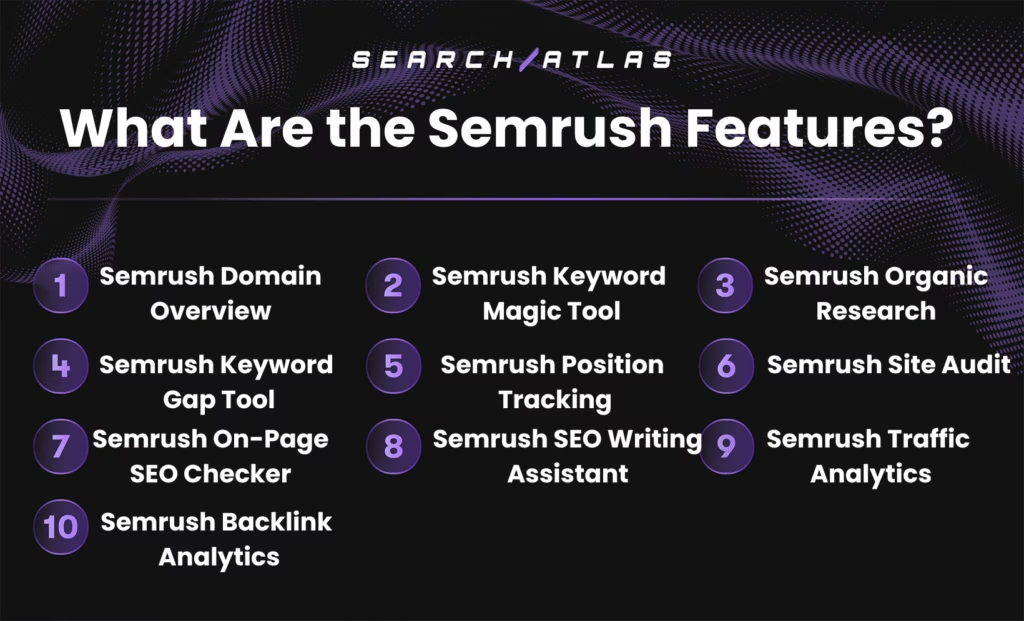
There are 10 main Semrush features used by marketers to monitor visibility, assess performance, and analyze competitor activity. The 10 main features of Semrush are listed below.
1. Semrush Domain Overview
Semrush Domain Overview is a tool that provides a general snapshot of a website’s online performance. Semrush Domain Overview includes estimates for total traffic, traffic sources, top-performing keywords, and backlink profiles. While the Semrush Domain Overview Tool brings together SEO and PPC data into one interface, users seeking more granular or real-time insights may find the tool somewhat limited. The Semrush Domain Overview platform is primarily useful for preliminary research rather than in-depth technical or campaign-level analysis.
Marketers often use the Semrush Domain Overview interface to benchmark competitors, review keyword coverage, and identify potential gaps in visibility. Users can examine which keywords drive traffic to competing sites, which pages perform well, and what types of backlinks support their rankings. These insights can help identify missed opportunities or areas for improvement. However, the tool may not always reflect the full complexity or accuracy of a competitor’s strategy. As such, the information from Semrush Domain Overview is best used for directional analysis rather than making final decisions without deeper investigation.
To use the Semrush Domain Overview, enter a domain, subdomain, or URL and select a geographic market.

The Semrush Domain Overview Tool will then generate a summary including keyword rankings, backlink counts, and top-performing content.
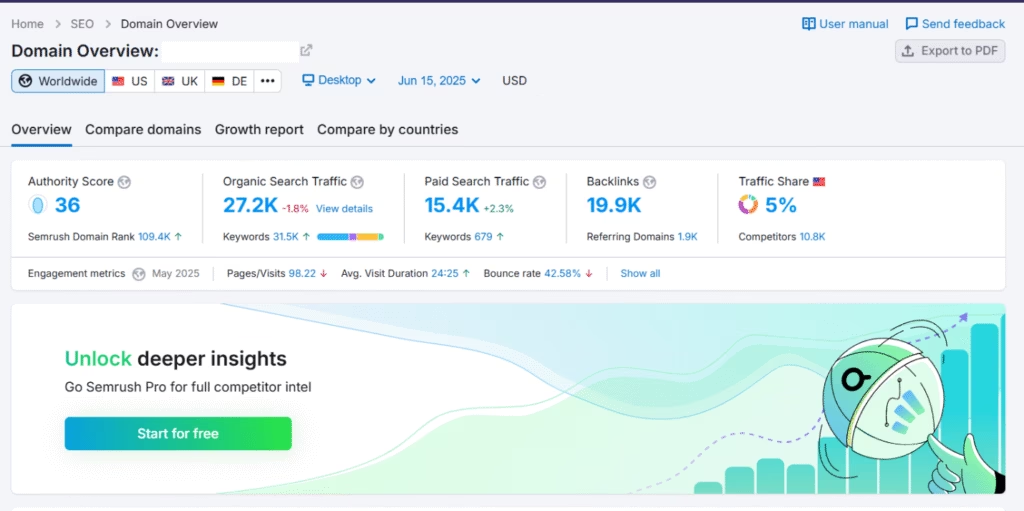
2. Semrush Keyword Magic Tool
The Semrush Keyword Magic Tool is designed to generate keyword suggestions from a single seed term. The Semrush Keyword Magic Tool pulls data from Semrush’s database to create an extensive list of related keywords and automatically groups them by topic, match type, and search intent. The Semrush Keyword Magic Tool supports keyword research for SEO and PPC campaigns and includes standard metrics such as search volume, keyword difficulty, cost-per-click, and competition level.
Marketing professionals use the Semrush Keyword Magic Tool to explore keyword variations at scale, which can be helpful when building topic clusters or identifying long-tail opportunities. Users can filter results by metrics like SERP features, question-type keywords, and word count to refine their targeting. However, the tool can be somewhat data-heavy, which may slow down decision-making for users looking for quick, focused insights. Additionally, metrics such as keyword difficulty offer general guidance and may not always account for nuanced ranking factors in different markets.
To use the Semrush Keyword Magic Tool, enter a broad keyword into the search field, select a target location, and click search.

The Semrush Keyword Magic Tool will then display hundreds of keyword suggestions grouped into subtopics.
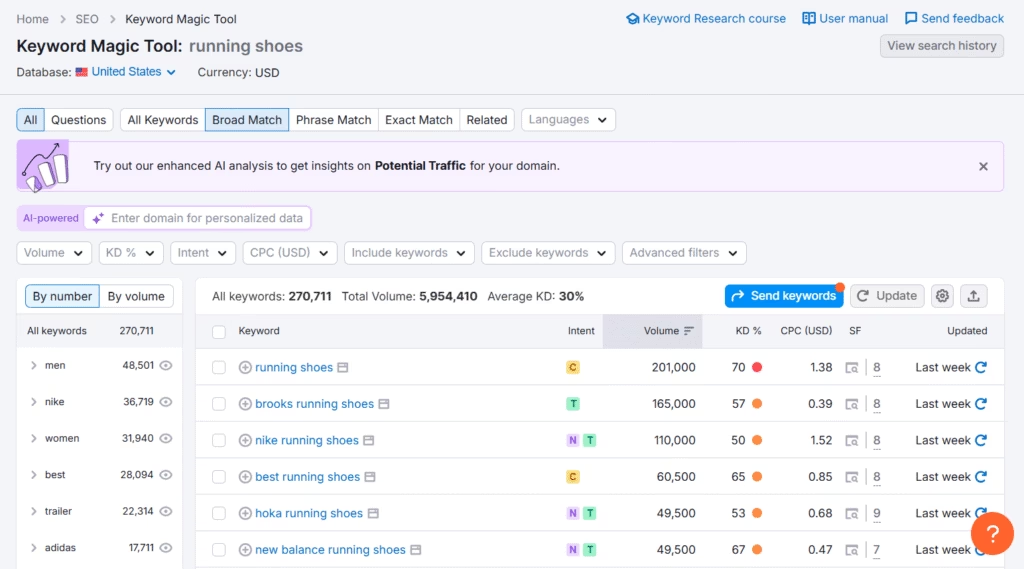
3. Semrush Organic Research
Semrush Organic Research is a tool that offers visibility into a website’s performance in organic search. The Semrush Organic Research Tool shows ranking keywords, estimated traffic, top pages, and competitor comparisons. The Semrush Organic Research Tool is commonly used by marketers to track how a domain performs on search engines and where its traffic is coming from. The data is laid out in a user-friendly format by the tool, but deeper insights often require switching between multiple reports and manual analysis.
A common use case of the Semrush Organic Research platform is competitor research. Users can see which keywords competitors rank for and which pages are generating visits. However, keyword traffic estimates can vary significantly from actual figures, so decisions based solely on this data should be made with caution. The tool does highlight position changes and trending keywords, but these shifts may lag behind real-time search engine updates, making it less reliable for agile SEO strategies. Additionally, long-term position tracking may require a higher-tier subscription.
The Semrush Organic Research dashboard helps evaluate your own domain, monitor keyword performance, and flag drops in rankings. The tool includes information on SERP features like featured snippets or video results, but these are limited to what Semrush’s crawlers detect, which might not always reflect what users see on search engines. The Semrush Organic Research interface is serviceable for performance reviews and spotting potential opportunities, but marketers looking for real-time accuracy and deeper content insights may find themselves supplementing this with additional platforms or tools.
To use the Semrush Organic Research Tool, enter a domain and select a country.

The Semrush Organic Research dashboard will then generate a summary of keywords, estimated traffic, and top pages.
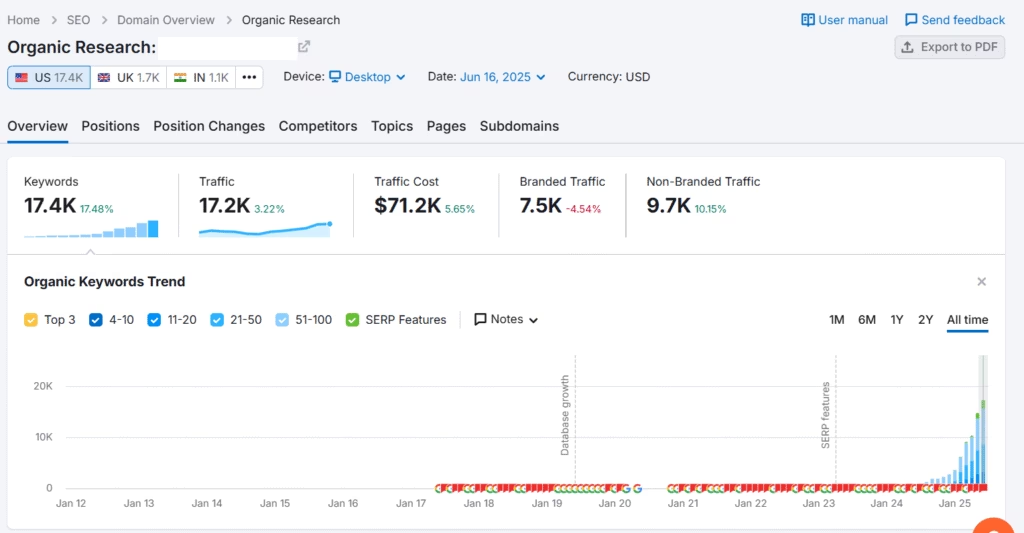
4. Semrush Keyword Gap Tool
The Semrush Keyword Gap Tool is designed to compare the keyword profiles of up to five domains. The Semrush keyword Gap Tool identifies shared, unique, and missing keywords across domains, giving users a general overview of which terms are present or absent across selected websites. This type of comparison can be useful for identifying keyword-targeting inconsistencies or potential content areas that have not been explored.
The Semrush Keyword Gap platform displays keywords that competitors are ranking for but your site is not. These insights may help identify content or SEO gaps, but it is worth noting that the value of such insights depends heavily on the quality and accuracy of the data being pulled. Traffic and ranking estimates are based on Semrush’s own crawling algorithms and may not always align with real-world performance, especially in niche industries or markets with low search volume.
The Semrush Keyword Gap dashboard includes filters for narrowing results by search volume, intent, keyword type, and more. However, the interface may require multiple clicks to access actionable details, and the segmentation into “missing,” “weak,” or “strong” keywords does not always account for factors like brand relevance or commercial intent. This could lead to misguided prioritization if used in isolation.
From a content and PPC perspective, the Semrush Keyword Gap interface can be used to identify terms competitors are targeting, which some marketers might treat as signals for developing blog content or paid search strategies. That said, relying too heavily on competitor data runs the risk of mimicking rather than innovating, and the absence of real-time SERP context can limit how tactical these insights really are.
To use the Semrush Keyword Gap Tool, enter your domain along with up to four competitors.
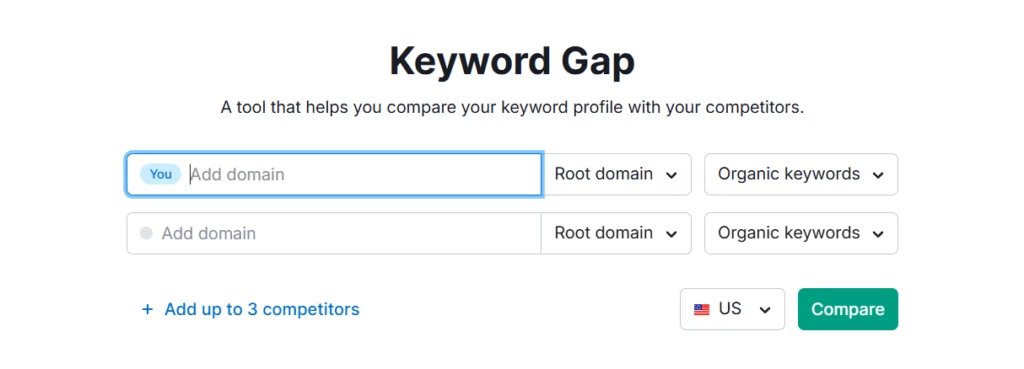
The Semrush Keyword Gap Tool will then generate a comparison view showing where keywords overlap and differences exist.
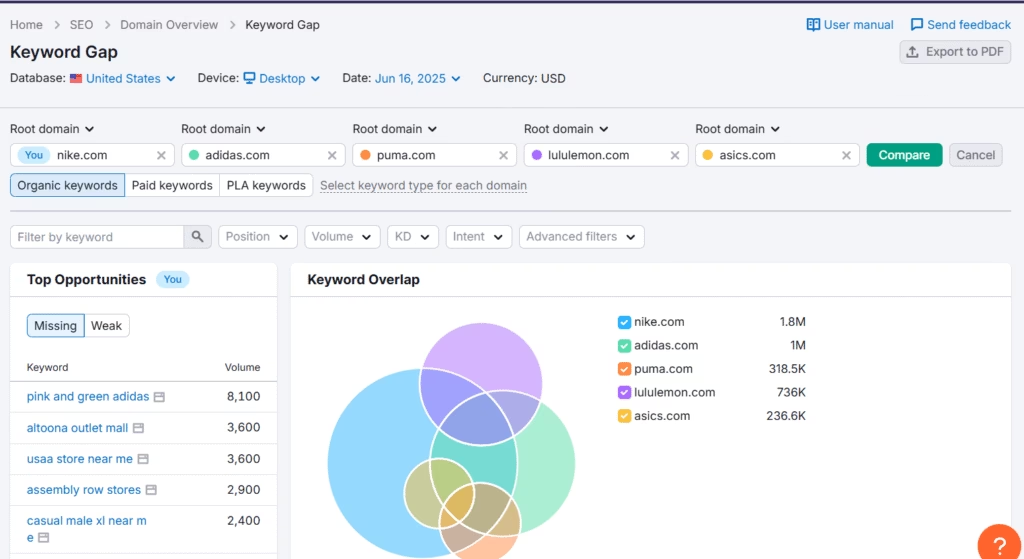
5. Semrush Position Tracking
Semrush Position Tracking is a tool designed to track the daily rankings of a website’s target keywords across search engine results pages (SERPs). The Semrush Position Tracking Tool supports tracking by device type (desktop or mobile) and location. Additionally, users can observe ranking movements for their own website and for selected competitors or individual URLs.
The Semrush Position Tracking dashboard is commonly used to track how rankings change following content updates, algorithm shifts, or strategic SEO adjustments. The Semrush Position Tracking interface presents ranking trends, position fluctuations, and overall visibility scores. While this offers helpful insights into keyword movements, it should ideally be used alongside more in-depth analysis, as the Semrush Position Tracking Tool does not offer much guidance on why rankings change.
Local and mobile tracking features cater to businesses operating in region-specific markets or optimizing for mobile-first indexing. However, accurate insights into hyper-local SEO performance may vary, particularly in areas with less search volume or inconsistent SERP behavior. Moreover, the tool tracks SERP features such as featured snippets and local packs, which can inform decisions about how to tailor content for enhanced visibility, although gaining those features remains outside the control of the tool itself.
To use the Semrush Position Tracking Tool, enter the domain or subdomain you want to monitor. Choose the geographic location, device type, and search engine, and upload or input your target keywords. The Semrush Position Tracking Tool will then provide daily updates showing current keyword rankings, visibility scores, ranking distribution, and SERP feature presence.

6. Semrush Site Audit
Semrush Site Audit is a tool designed to scan websites for technical SEO issues that may affect their visibility in search engines. The Semrush Site Audit Tool checks a wide range of factors, including crawlability, HTTPS setup, duplicate content, page performance, broken links, and Core Web Vitals. The Semrush Site Audit Tool offers users a general overview of a website’s technical health.
The primary function of the Semrush Site Audit platform is to identify technical issues that might otherwise go unnoticed. These technical SEO issues could include crawl errors, redirect chains, missing meta tags, or improperly implemented structured data. While the Semrush Site Audit platform does help highlight potential problems, users should be aware that not all flagged issues are equally critical, and interpreting which findings truly impact SEO requires a degree of expertise.
Additionally, the Semrush Site Audit interface provides suggestions for resolving these issues. The guidance is generally helpful, but the platform tends to flag a large volume of minor warnings, which may overwhelm users who are not sure how to prioritize fixes or who rely on the tool alone to assess technical health.
The Semrush Site Audit Tool displays an overall site health score and tracks changes over time, allowing teams to monitor progress after fixes have been implemented. Users can customize crawl settings (e.g., number of pages scanned, crawl source, and user agent), and the reports can be filtered based on severity to focus on more pressing concerns. Moreover, integration with Google Analytics and Search Console can supplement the findings with additional data points, but the actual insights depend on how effectively that data is interpreted in context.
To conduct an SEO audit using the Semrush Site Audit Tool, enter the domain to be scanned, configure the crawl parameters, such as page limit and crawl source, and then launch the audit.

Once completed, the Semrush Site Audit Tool outlines technical issues broken down by severity, such as errors, warnings, and notices.
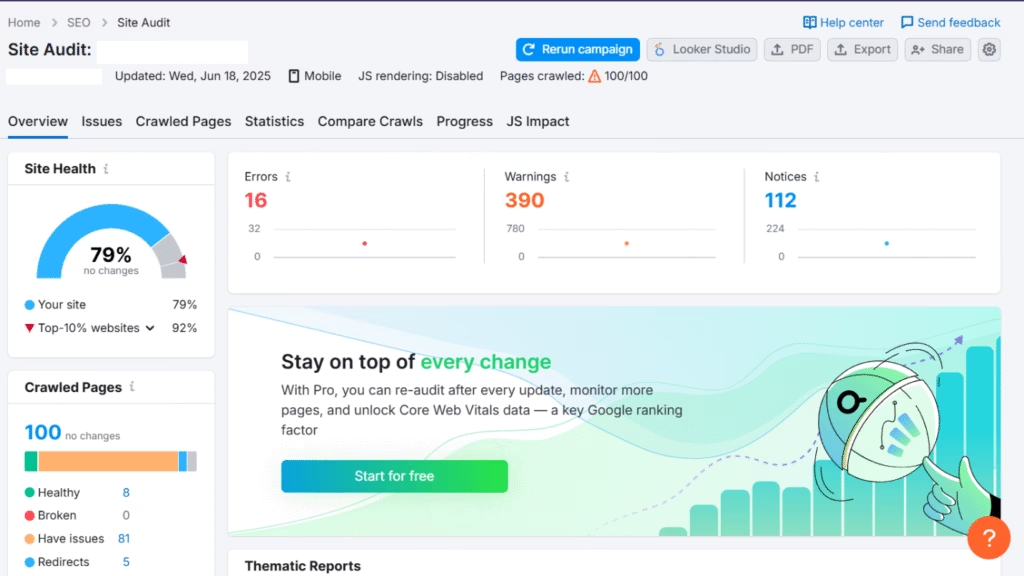
7. Semrush On-Page SEO Checker
Semrush On-Page SEO Checker is a tool developed to evaluate individual web pages and suggest improvements that may help boost their visibility in search results. The Semrush On-Page SEO Checker analyzes various factors such as keyword use, content structure, metadata, internal linking, and technical SEO indicators. Additionally, the Semrush On-Page SEO Checker Tool pulls in insights from competitor pages to provide a benchmark comparison.
The Semrush On-Page SEO Checker tool presents tailored suggestions based on a page’s current SEO performance and comparison to top-ranking competitors. Recommendations are grouped into categories, such as strategy, content, backlinks, and SERP features, and users can export task lists or assign them for implementation. While the tool can support optimization workflows, its usefulness will depend on how well users apply the insights within the context of their broader SEO goals.
The Semrush On-Page SEO Checker dashboard may identify areas where content can be strengthened with semantically related keywords, where meta tags need refining, or where backlink acquisition could support visibility. This information makes the tool useful for identifying specific gaps in existing content and flagging optimization opportunities that are easy to overlook manually. However, not every on-page SEO recommendation provided by the Semrush On-Page SEO Checker interface will be equally valuable. Users are advised to review suggestions in context and apply judgment when deciding what to implement, especially when it comes to keyword usage or changes that could impact user experience.
To use the Semrush On-Page SEO Checker Tool, enter your domain and select your target country.
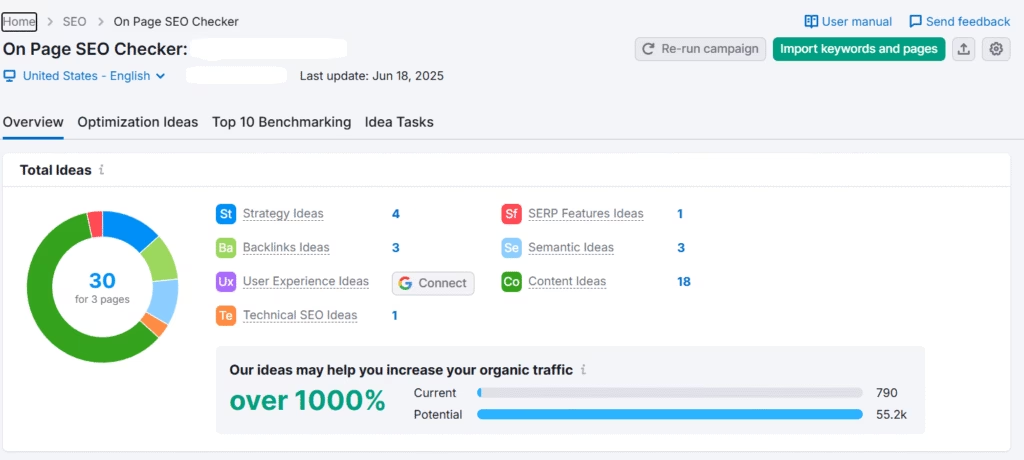
After scanning, the Semrush On-Page SEO Checker Tool will generate page-specific suggestions categorized by issue type.

8. Semrush SEO Writing Assistant
Semrush SEO Writing Assistant is a tool developed to help writers and marketers optimize their content in real-time. The Semrush SEO Writing Assistant evaluates content against a chosen target keyword and provides suggestions based on SEO, readability, tone of voice, and originality. The Semrush SEO Writing Assistant Tool is available as a built-in feature on Semrush, as well as plugins for Google Docs and WordPress.
The Semrush SEO Writing Assistant checks if the target keyword is placed in strategic locations like titles and subheadings, and flags potential keyword stuffing. Additionally, the Semrush SEO Writing Assistant dashboard suggests semantically related terms to improve topical relevance. However, the keyword suggestions are not always tailored to the context of the content. Writers often receive terms that do not naturally fit the tone or topic, which may force awkward phrasing or lead to over-optimization. Additionally, there is limited nuance in how the tool handles intent, which is increasingly important in modern SEO.
The Semrush SEO Writing interface analyzes the tone of voice to see if the writing matches the intended brand personality. However, the tone analysis is not always precise. The Semrush SEO Writing Assistant Tool sometimes misclassifies neutral or professional writing as needing changes, especially in highly formal or industry-specific contexts. Moreover, originality checks help flag potential duplicate content, but they may occasionally misidentify common phrases or citations as issues. That said, it is advisable to manually verify originality flags before making major revisions.
To use the Semrush SEO Writing Assistant, enter a target keyword and either paste existing content or start writing within the editor.
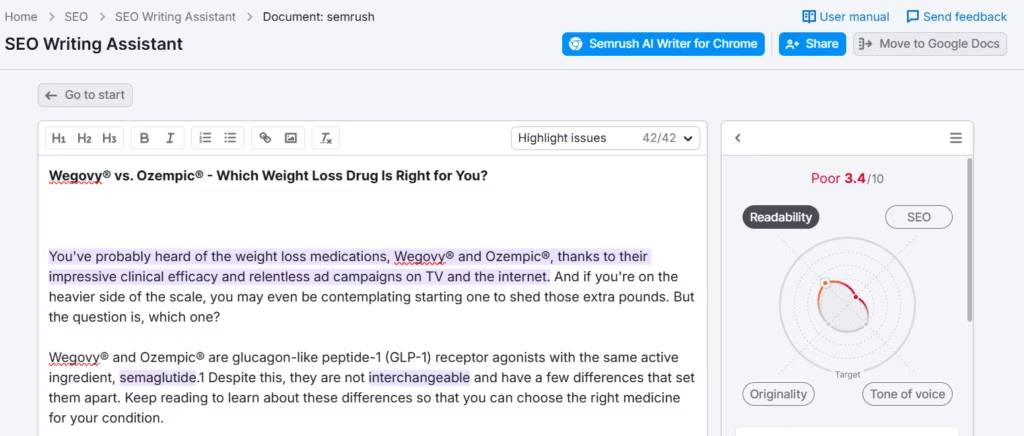
The Semrush SEO Writing Assistant will then provide suggestions categorized under SEO, readability, tone, and originality.

9. Semrush Traffic Analytics
Semrush Traffic Analytics is a tool that provides estimated data on website traffic, user behavior, and engagement metrics. The Semrush Traffic Analytics displays total visits, unique visitors, average session duration, bounce rate, and traffic breakdown by source, location, and device type. Semrush users can analyze both their own domains and competitors’ sites to get an overview of general traffic patterns.
The Semrush Traffic Analytics Tool reports which channels, such as organic search, paid ads, referrals, direct, and social, are estimated to be driving traffic to a given site. However, it is worth noting that the traffic numbers are estimates, not actual figures. These estimations can lead to inaccuracies, especially for smaller or newer websites with less public data available.
The Semrush Traffic Analytics dashboard shows historical traffic trends, allowing users to monitor spikes or dips that may suggest successful campaigns or problems. The Semrush Traffic Analytics interface helps evaluate a competitor’s digital presence before outreach or investment. That said, engagement metrics like bounce rate or session duration should be taken with caution because Semrush does not have access to internal analytics. These engagement metrics are modeled data, not precise figures, and this limits the Semrush Traffic Analytics Tool’s effectiveness for in-depth behavioral analysis or campaign attribution.
To use the Semrush Traffic Analytics Tool, enter your domain. The Tool allows you the option to add up to four competitors for comparison.
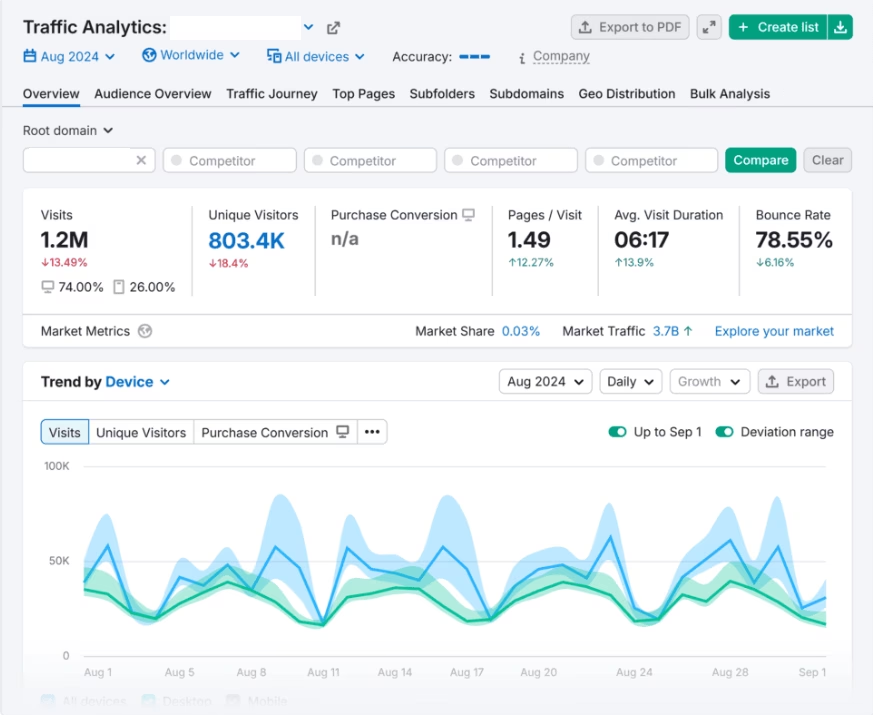
The Semrush Traffic Analytics Tool will then generate a dashboard with estimated visit numbers, channel distribution, geographic traffic sources, and device usage.

10. Semrush Backlink Analytics
Semrush Backlink Analytics is a tool developed to examine the backlink profile of any website. The Semrush Backlink Analytics offers data on referring domains, anchor texts, backlink types, top linking pages, and the number of new and lost links over time. The Semrush Backlink Analytics can be used to assess both a site’s own link profile and that of competitors.
The Semrush Backlink Analytics Tool offers visibility into which domains are linking to a competitor’s site, how frequently, and through what types of backlinks. This data may inform decisions on potential outreach opportunities or highlight which types of content tend to attract links within a specific niche. However, the Semrush Backlink Analytics dashboard does not provide context around the placement or intent of each link, so further validation is often necessary before acting on the insights.
The Semrush Backlink analytics interface includes basic risk assessment features, such as identifying backlinks that Semrush classifies as toxic. While this can serve as an early warning system, it is important to note that the criteria used to define toxicity are based on Semrush’s internal model and may not reflect actual penalties from search engines. Additionally, the lost links and referring domain trends can help detect sudden shifts in backlink profiles, but data accuracy may vary based on Semrush’s crawler limitations. Moreover, filters such as link attribute, country, and domain type support basic segmentation, but deeper link analysis may require more granular tools or manual investigation.
To use the Semrush Backlink Analytics Tool, enter a domain in the search field.

The Semrush Backlink Analytics Tool will then return an overview of backlink totals, referring domains, backlink types, and authority scores.

How Does the Semrush Tool Work?
The Semrush Tool works by collecting and analyzing large volumes of online data from search engines, websites, and third-party providers to report on keyword rankings, domain visibility, backlinks, estimated traffic, and competitive positioning. The Semrush Tool uses its own crawlers and databases to track shifts in SERPs, monitor keyword trends, audit websites, and evaluate digital marketing performance. Users can input domains, keywords, or URLs into the Semrush tools to generate reports and visualizations that aim to support decisions in areas like SEO, paid search, and content strategy.
While the Semrush platform provides a consolidated view through dashboards and charts, some users may find that the interface prioritizes volume over clarity, requiring additional effort to interpret the data accurately. Additionally, Semrush’s estimates, especially for traffic and keyword volumes, are not always perfectly aligned with real-world figures. Verification with first-party analytics like Google Analytics is recommended for critical decisions.
How Accurate is Semrush Tool?
Semrush is generally considered accurate when it comes to SEO research, keyword analysis, and competitor benchmarking.
However, Semrush’s accuracy, particularly in traffic estimation, has been questioned in various studies. An analysis by Screaming Frog comparing traffic predictions across various SEO tools found that Semrush underestimates traffic by an average of 42%. Another deeper study published by Promodo reported an even higher average error rate of 61.6% for Semrush, often skewed toward traffic overestimation. The discrepancies were reportedly more evident in smaller websites or niche markets where sample sizes are limited.
While Semrush still offers utility for high-level competitive research and trend spotting, marketers aiming for precision would be better served by pairing Semrush data with verified first-party analytics when making critical performance decisions.
What Pricing Plans Does Semrush Tool Offer?
The Semrush Tool offers 3 main pricing plans, each designed to cater to different business sizes and user needs. The Semrush Pro Plan serves as the basic tier, intended for individual marketers and small teams. The Pro Plan is priced at $139.95/month and includes standard tools like keyword research, position tracking, and site auditing. Users can manage up to 5 projects and track a maximum of 500 keywords, which can become restrictive fairly quickly, especially for users managing multiple websites or clients.
The Semrush Guru Plan is aimed at mid-sized agencies and in-house teams and includes additional features such as historical data and content marketing tools. The Guru Plan is priced at $249.95/month and increases the keyword tracking limit to 1,500 and allows more project slots. However, the jump in cost does not always align with the incremental value, particularly if your focus is primarily on technical SEO rather than content workflows.
The Semrush Business Plan is priced at $499.95/month and targets larger agencies and enterprises. The Business plan offers white-label reporting, API access, and the ability to track up to 5,000 keywords. The Business Plan includes more robust data tools and integrations, but some users find that access to deeper insights, like product listing ads or advanced reporting, still comes with certain restrictions or extra setup requirements.
Additionally, the Semrush SEO Tool includes a custom enterprise option, where pricing and features are tailored. However, the details on the option are not transparent and must be requested directly, which may not appeal to teams seeking immediate clarity on ROI.
The Semrush Tool does offer a 7-day free trial on request for Pro and Guru plans, but this is not always openly promoted for all plans and may require a request or special link. These paywalls and thresholds may present barriers to fully exploring the platform’s capabilities without an upfront commitment for users comparing tools.
Semrush may be worth it for businesses and professionals who require a broad set of digital marketing tools in one place. However, Semrush’s pricing structure can be steep, and many features are locked behind higher-tier plans. The return on investment may not justify the ongoing cost for those who don’t need the full suite or who prefer more flexible, modular solutions. It is important to weigh actual usage needs against what is included before committing long-term to any tool.
What is the Semrush Tool Rating?
Semrush receives varied ratings across different software review platforms. The varied feedback reflects Semrush’s comprehensive feature set alongside user dissatisfaction around pricing and interface. The Semrush reviews across major software review sites are listed below.
- Trustpilot. 2.8 / 5 (939 reviews)
- Capterra. 4.6 / 5 (2292 reviews)
- G2. 4.5 / 5 (2654 reviews)
- TrustRadius. 8.6 / 10 (760 reviews)
- Gartner Peer Insights. 4.4 / 5 (98 reviews)
The ratings reflect a mature product with broad capabilities, but Semrush may not be equally well-suited for all user types or business sizes. Semrush users highlight the tool’s wide features. At the same time, Semrush users point to challenges around pricing, interface complexity, and support responsiveness.
What Are the Pros of Semrush?
The pros of Semrush lie in its all-in-one approach, offering tools for SEO, content development, competitor research, and campaign monitoring. The pros of Semrush are given below.
- All-in-One Access. Semrush includes tools covering SEO, paid ads, content, and competitive research in a single platform.
- Detailed Keyword Metrics. Semrush offers keyword data such as volume, difficulty, and intent, which is useful for search planning.
- Competitor Insights. Semrush displays basic competitor data, including keywords, backlinks, and traffic channels, although accuracy may vary by site size.
- Link Monitoring. Semrush allows users to check backlink profiles and track changes, including new and lost links.
- Link Building Tools. Semrush includes built-in features for organizing backlink campaigns, similar to a basic CRM.
- Data Visualization. Semrush presents reports and trends through visual charts to simplify interpretation.
- Accessible Dashboard. Semrush’s interface is structured logically, although some advanced features require a learning curve.
- Custom Reports. Semrush allows users to generate automated, white-labeled performance reports.
Semrush offers a reasonable number of features that appeal to marketers seeking an all-in-one solution. However, many of Semrush’s strengths come with limitations that may affect accuracy, accessibility, or overall value depending on user needs.
What Are the Cons of Semrush?
The cons of Semrush lie in several areas that may affect its fit for certain users. The cons of Semrush are given below.
- High Cost. Semrush’s pricing structure may be too expensive for individual users, freelancers, or small businesses with limited budgets. Even Semrush’s entry-level plan requires a significant monthly commitment.
- Limited Access on Lower Tiers. Semrush’s entry-level plans come with strict limits on projects, keyword tracking, and reports.
- Data Inaccuracy. Semrush’s traffic estimates are not always precise, especially for smaller sites.
- The Interface Can Feel Cluttered. Semrush’s dashboard and tools are dense with features, which can make navigation feel unintuitive and time-consuming for some users.
- Steep Learning Curve. Semrush’s wide range of tools and data can be overwhelming for new users without prior SEO experience.
- Extra Costs for Add-ons. Features like additional users, local SEO tools, or agency growth kits require extra payment.
- One User Account Per Plan. Even Semrush’s high-tier plans allow only one user login unless you pay extra for additional seats.
- Restricted API Access. API is only available with higher-tier plans, limiting integration capabilities for Pro users.
- Some Tools Are Still in Beta. Several of Semrush’s newer AI and content tools are still in development or beta, with inconsistent output or unclear long-term value.
- Limited Historical Data on Pro Plan. Historical performance data is only available in Semrush’s higher-tier plans, like Guru and Business.
These drawbacks suggest Semrush is best suited for teams with budget flexibility and experience navigating robust analytics platforms. The value may not fully justify the cost for smaller operations or beginners.
What Do Reddit Users Think About Semrush?
Reddit users express a wide range of opinions about Semrush. Many Reddit users describe Semrush as a reliable all-in-one solution for keyword research, backlink tracking, and competitor analysis. However, a strong current of criticism runs through Reddit threads, especially regarding Semrush’s price, accuracy, and limited access.
The most frequent complaints on Reddit revolve around Semrush’s high pricing. Many Reddit users feel that Semrush’s monthly fees are too high compared to other SEO tools in the market. Additionally, several Reddit users point out that other Semrush tool alternatives provide the same functionality for a more reasonable cost.
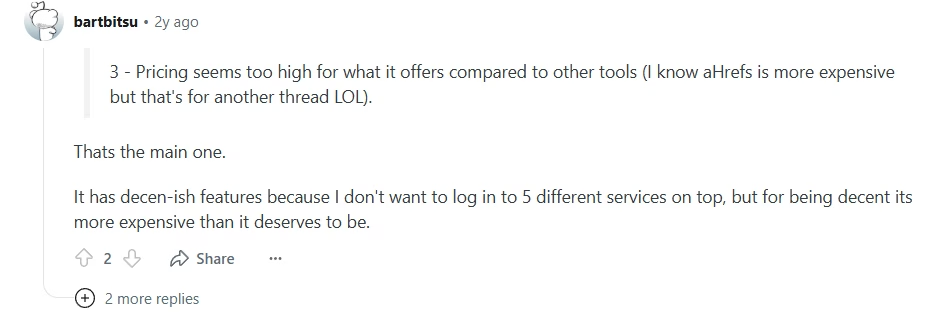
Some Reddit users express frustration with Semrush’s limited access to lower-tier plans. Key features of Semrush, like content marketing tools, are locked behind higher-tier plans. This restriction leaves many Reddit users feeling disappointed that they can’t simply add these features to a lower-tier subscription without paying for unnecessary extras they don’t need.

Concerns about data reliability are just as prominent. Many Reddit users report significant inconsistencies in keyword volume estimates and traffic numbers, especially when comparing Semrush data with Google Search Console or Analytics. Reddit users note that Semrush often underestimates or misattributes organic traffic, and some of the keyword difficulty scores are viewed as misleading or outdated.
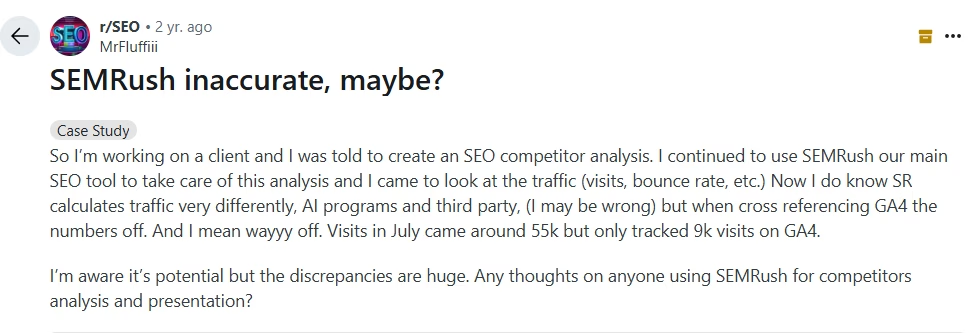
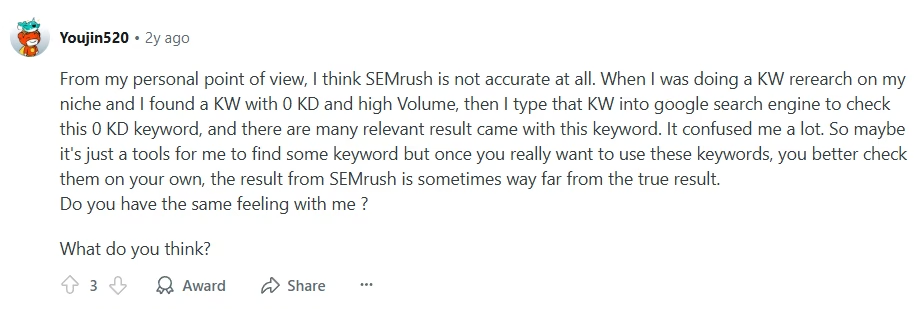

Additionally, Semrush’s subscription management process has drawn criticism from Reddit users. Many Reddit users report that cancellation options are not always immediately visible, and the platform often requires users to go through customer support or multiple steps to end their plan. This approach is seen by Reddit users as deliberately inconvenient and adds to the frustration.

While some Reddit users support Semrush for its capabilities, the broader Reddit community leans toward skepticism. Many Reddit users feel that Semrush is more of a premium tool for agencies and advanced users rather than a must-have for SEO beginners or small teams. This sentiment has had many users frequently discussing moving away from Semrush to other alternatives.
How Does Semrush Treat Its Long-term Subscribers?
Semrush’s treatment of its long-term subscribers has sparked frustration and backlash over time. Semrush frequently updates its features, which long-time users may find valuable if they actively use the platform’s full toolkit. However, when it comes to the actual treatment of Semrush’s loyal users, the sentiment from public forums and reviews is less favorable.
Semrush does not appear to offer any formal loyalty program or consistent discounts for long-term subscribers. Instead, Semrush users report rising renewal costs, even when no new tools are being added to their workflow. Some Semrush users mention reduced functionality unless they upgrade to more expensive tiers, effectively penalizing users who stay on lower plans over time.
Semrush does offer some pricing flexibility through its standard annual subscription discount (up to 17%). However, this is common across SaaS platforms and not exclusive to Semrush’s loyal or long-term users.
While Semrush continues to invest in product improvements, it does very little to recognize or retain long-term customers through pricing flexibility, exclusive features, or loyalty perks. Semrush’s focus remains on feature expansion and upselling, rather than customer-centric retention strategies that reward sustained use or brand loyalty.
How Responsive is Semrush’s Customer Support?
Semrush’s customer support receives mixed feedback across user reviews and forums regarding responsiveness and helpfulness. Semrush provides live chat, email support, and phone-based assistance. However, the live chat and phone support are limited to weekday business hours. Email support is available 24/7, but responses may take up to one business day.
Some Semrush users find the support team responsive and helpful for common issues and general inquiries. However, other Semrush users report less satisfactory experiences. Complaints often focus on slow responses, especially for billing or cancellation issues, and frustrating support workflows, such as needing to contact support just to cancel a subscription. Additionally, some Semrush users note that support reps tend to push upgrades or upsells instead of resolving concerns directly.
How Reliable and Legit is Semrush as an SEO Tool?
Semrush is generally considered a reliable and legitimate SEO tool by most professionals in the digital marketing industry. However, some users on platforms like Reddit have referred to Semrush as a scam, mostly out of frustration with certain business practices rather than actual fraud. These complaints usually center around auto-renewals, unclear cancellation procedures, and being charged unexpectedly after a trial ends. Additionally, there is criticism around feature gating, where core tools are locked behind expensive plans and unexpected price hikes without added value. These recurring issues have led some to question Semrush’s ethics and label it as predatory in how it handles subscriptions.
What is the Best Alternative to Semrush Tool?
The best alternative to the Semrush Tool is the Search Atlas SEO Software Platform. The Search Atlas SEO Software Platform is a US-based SaaS company that provides powerful SEO tools designed to support marketing professionals, agencies, and businesses of all sizes around the world. The Search Atlas SEO Software Platform delivers cost-effective, user-friendly solutions to help improve online visibility, drive traffic, and grow your digital presence.
The Search Atlas SEO Software Platform offers a revolutionary approach to SEO that combines advanced AI automation with traditional SEO tools. The Search Atlas SEO Software Platform delivers a comprehensive SEO suite that includes in-depth backlink and keyword research, AI-powered content tools, on-page and technical audits, competitor tracking, rank monitoring, and outreach automation, with seamless GSC, Google Analytics, and Google Business Profile integration.
The Search Atlas SEO Software Platform’s game-changing Otto SEO Tool serves as an in-house SEO strategist, recommending tailored tasks to optimize your website, grow your keyword rankings, and improve your technical SEO health. Otto SEO Tool can help automate technical SEO, content optimization, and more, providing users with a dedicated AI assistant that works continuously to enhance their SEO performance without manual intervention.
The Search Atlas SEO Software Platform starts at $99 per month and offers flexible pricing plans that cater to different needs and budgets, making it a cost-effective choice for professionals and agencies of all sizes. Additionally, the Search Atlas SEO Software Platform offers white-label solutions for agencies and is trusted by 5,000+ digital marketers and agencies to optimize their workflows. With its combination of AI-powered automation, comprehensive toolset, and proven results, the Search Atlas SEO Software Platform represents the future of intelligent SEO management.
Ready to switch to a smarter, all-in-one SEO platform? Migrate from Semrush to Search Atlas SEO Software Platform today and unlock advanced tools for backlink analysis, AI content optimization, and outreach, without overpaying.
Are There Any Other Semrush Alternatives?
Yes, there are several strong Semrush alternatives that cater to different SEO needs and budgets. SEO tools like the Search Atlas SEO Software Platform, SE Ranking, Serpstat, Ahrefs, Moz, SpyFu, and SimilarWeb provide similar features such as keyword tracking, backlink analysis, site audits, and competitor research. All Semrush alternatives come with their strengths and weaknesses, so the right choice depends on your specific SEO goals and budget.
Do SEO Professionals Rank Semrush Among the Best SEO Tools?
Yes, many SEO professionals consider Semrush among the best SEO tools due to its extensive toolset, including keyword research, competitor analysis, backlink tracking, and content optimization. However, some SEO professionals prefer other SEO tools based on pricing, support, or specific use cases.


